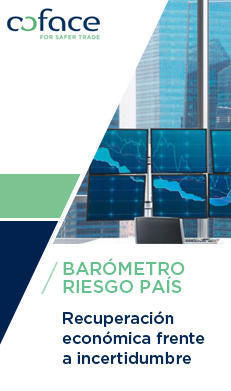

Namibia
Synthesis
major macro economic indicators
| 2020 | 2021 | 2022 | 2023 (e) | 2024 (f) | |
|---|---|---|---|---|---|
| GDP growth (%) | -8.0 | 3.5 | 4.6 | 3.0 | 3.0 |
| Inflation (yearly average, %) | 2.2 | 3.6 | 6.1 | 5.0 | 4.5 |
| Budget balance (% GDP) | -8.2 | -8.7 | -5.2 | -5.0 | -4.5 |
| Current account balance (% GDP) | 2.8 | -9.9 | -12.3 | -6.0 | -4.0 |
| Public debt (% GDP) | 66.6 | 71.9 | 69.8 | 70.0 | 72.0 |
(e): Estimate (f): Forecast *Fiscal year from April 1 to March 31. 2021 Data: FY 2023/2024
STRENGTHS
- Major mineral resources (diamonds, gold, uranium, copper) and fish stocks
- Good transport infrastructure and long coastline
- Well-developed local financial market
- Satisfactory governance and stable democracy since 1990
- Tourism potential
- Discovery of offshore hydrocarbon deposits
- Prospects for green hydrogen production
- Namibian dollar pegged to the rand
WEAKNESSES
- Dependence on the mining sector and on South Africa, particularly for its electricity supply
- High unemployment, persistent inequality, tensions over land ownership, high prevalence of AIDS
- Agricultural sector exposed to the vagaries of the weather
- High public debt limits fiscal headroom
RISK ASSESSMENT
Moderate growth underpinned by the mining sector
Following on from 2022, Namibian growth will be underpinned in 2023 and 2024 by the mining sector (12% of GDP in 2022). Production and exports of diamonds, gold and uranium will be driven by external demand and high prices for these minerals, which accounted for 43% of the country's exports in 2022. In particular, demand for local diamonds will continue to be stimulated by North American sanctions and the voluntary embargo on Russian diamonds applied by major jewelers: the measures affecting the Russian diamond company ALROSA, which held around 30% of the world’s market share before the war in Ukraine, have opened up outlets for Namibian diamonds and boosted their price. In addition, the addition of the diamond recovery vessel "Benguela Gem" to Debmarine Namibia's fleet in March 2022 has boosted production as of 2023. The business is also benefiting from the upturn in tourism following the normalisation of the global health situation and the withdrawal, in July 2022, of the last remaining health measures in the country. Nevertheless, the outlook for growth has been tarnished by South Africa's sluggish economy and the prevailing uncertainty surrounding the agricultural sector that is highly dependent on weather conditions, which are becoming increasingly volatile as a result of climate change. In addition, agricultural production will continue to be impeded by the high price of fertilisers owing to the Russian-Ukrainian conflict. Inflation will also weigh on household consumption due to persistently high prices of imported food and fuel. Nonetheless, inflationary pressures should ease as a result of monetary tightening, both globally and locally. While the key rate was already increased from 3.75% to 7.75% between February 2022 and June 2023, the pegging of the Namibian dollar to the South African rand could lead to further tightening by the Bank of Namibia against a backdrop of durably high inflation.
Durably significant twin deficits
After deteriorating sharply in 2021 and 2022 due to soaring food and fuel import prices, the current account balance will improve in 2023 and 2024. The deficit should narrow as a result of the rise in export revenues, particularly from diamonds, which will partially offset energy and food imports, as well as those required by the development of mining activity. Tourism receipts will continue to be offset by purchases of mining services, while payments from the Southern African Customs Union (SACU) should increase. A large part of the deficit will be financed by foreign investment, particularly in oil and gas exploration.
The budget deficit, which was widened by expenditure generated by the pandemic and then maintained at a high level by high world food and energy prices, has narrowed over the 2022-2023 period thanks to economic recovery. It will continue to fall – modestly – in 2023-2024 and 2024-2025 as revenues from SACU increase. In 2021 and 2022, member countries had to reimburse revenues for 2020 that had been overestimated in December 2019 due to the failure to anticipate the drop in trade prompted by the pandemic. At the same time, however, social spending will remain strong in the run-up to the 2024 elections, thereby moderating the government's efforts at fiscal consolidation. In addition, moderate growth, budgetary rigidity and rising interest rates will lead to an increase in public debt until 2025. Around 40% of external debt (25% of the total) is held by multilateral creditors following the emergency financing granted by the IMF and the African Development Bank, and 37% by the holders of eurobond 2025.
SWAPO still dominant ahead of the 2024 elections
SWAPO has dominated the political landscape since the country's independence in 1990, and its leader, Hage Geingob, was re-elected president for a second five-year term in 2019. Despite an erosion of its popularity, due to a difficult economic context since 2016, exacerbated by the Covid-19 pandemic and the persistence of high levels of inequality, SWAPO remains dominant ahead of the November 2024 elections. Netumbo Nandi-Ndaitwah was appointed deputy party President at the 2022 SWAPO Congress and is expected to succeed Geingob, who has reached the two-term limit. The controversial issue of land redistribution in favour of the black populations dispossessed during colonisation, who, although in the majority, own only 16% of agricultural land, will remain a pressing question and is symptomatic of the divisions within the country. Furthermore, although relatively favourable compared to other African countries, the business climate suffers from lengthy administrative procedures and is subject to competition from many African countries that have made this issue a pillar of their development strategies. Internationally, Namibia and South Africa will continue to enjoy close relations, facilitated by the proximity between their governing parties and their strong trade links. Namibia will also continue to strengthen its relationship with Angola under the bilateral oil and gas cooperation agreement signed in November 2022, following the discovery of new fields in 2022. In addition, the Zambian and Namibian governments have also decided to strengthen their bilateral cooperation with measures such as the cancellation of double taxation and the creation of a single border office. Last, a call for expressions of interest for the Trans-Kalahari rail project was launched jointly with neighbouring Botswana. When completed, the 1,500km network should link the Mmamabula coal mine in Botswana to the Namibian port of Walvis Bay, thereby boosting mineral exports from both countries.
Last updated: October 2023






